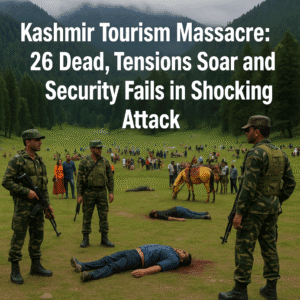Kashmir Tourism Massacre: 26 Dead, Tensions Soar and Security Fails in Shocking Attack
A deadly massacre in Kashmir’s Pahalgam region on April 22, 2025, where gunmen killed 26 tourists and injured 17, has shattered Indian Prime Minister Narendra Modi’s narrative of restored peace in the contested territory. The attackers, disguised as soldiers, exploited glaring security lapses in a tourist hotspot surrounded by military checkpoints, exposing overconfidence in India’s counterinsurgency strategy.
India blamed Pakistan for backing the assault, retaliating with missile strikes on suspected militant bases, while Islamabad denied involvement, escalating tensions between the nuclear rivals. Experts argue Modi’s government ignored warning signs, prioritizing tourism-driven optics over vigilance, as the region’s record visitor numbers masked unresolved militancy. The attack mirrors tactics used in a recent Baloch insurgent strike in Pakistan, deepening suspicions of tit-for-tat proxy warfare.
Calls for military action in India clash with warnings against reactionary nationalism, as global leaders urge de-escalation. Meanwhile, Kashmir’s fragile economy and traumatized communities face renewed uncertainty, underscoring how geopolitical posturing overshadows grassroots stability. The crisis highlights the peril of conflating tourism with lasting peace in a region where violence remains a tool of political brinkmanship.

Kashmir Tourism Massacre: 26 Dead, Tensions Soar and Security Fails in Shocking Attack
A serene meadow in Kashmir’s Pahalgam, famed for its Himalayan vistas and bustling with tourists, became the site of a horrific massacre on April 22, 2025. Gunmen disguised in military attire targeted Hindu travelers, killing 26 and wounding 17. The attack not only shattered Prime Minister Narendra Modi’s narrative of restored normalcy in Kashmir but reignited volatile tensions between nuclear-armed rivals India and Pakistan. As global leaders scramble to mediate, the incident underscores deep-rooted security failures and geopolitical complexities in one of the world’s most militarized regions.
The Attack and Its Aftermath:
The assailants exploited glaring security gaps in Baisaran, a tourist hotspot accessible via multiple security checkpoints. Despite Modi’s administration touting Kashmir’s revival through record tourism, no forces were present to protect over 1,000 visitors that day. Survivors described chaos as gunmen fired at close range, sparing women and children—a tactic mirroring a March 2025 Baloch insurgent attack in Pakistan, which Islamabad blamed on India.
India swiftly accused Pakistan of orchestrating the massacre, retaliating with missile strikes on alleged militant bases in Pakistani territory. Pakistan denied involvement, responding with visa bans and diplomatic expulsions. The cycle of escalation echoes past crises, raising fears of uncontrolled brinkmanship.
Security Failures and Political Overconfidence:
Experts argue Modi’s government prioritized optics over vigilance. “We bought our own narrative,” admitted former intelligence officer Avinash Mohananey, highlighting ignored warnings after the Baloch incident. The region’s heavy militarization focused on counterinsurgency in remote Jammu forests, leaving tourist hubs vulnerable.
Kashmir’s tourism boom—4.2 million visitors in 2024—was marketed as proof of stability post-2019 autonomy revocation. Yet, retired General D.S. Hooda notes, “Tourism isn’t a true barometer of peace.” Local leaders had cautioned against conflating visitor numbers with lasting security, citing persistent militancy in border areas.
Geopolitical Repercussions:
The attack amplifies calls within India for decisive action against Pakistan, with media channels fueling demands for military intervention. However, analysts like counterterrorism expert Ajai Sahni warn against reactionary measures: “Military talk thrives in echo chambers, not strategy rooms.”
Historically, both nations have relied on third-party mediation to de-escalate. Yet Modi’s 2019 Kashmir policy, which sidelined diplomatic channels, complicates international involvement. U.S. and U.N. appeals for restraint face skepticism, as India insists on addressing “the fountainhead of terrorism”—a veiled reference to Pakistan’s alleged militant ties.
Human Cost and Regional Sentiment:
Beyond geopolitics, the massacre traumatized a region already scarred by conflict. Kashmiri businesses, reliant on tourism, now face closures as 40 resorts shut down. Locals fear renewed crackdowns, while Hindu pilgrims question safety ahead of the Amarnath Yatra, a major religious trek.
“This wasn’t just an attack on Indians—it’s an assault on Kashmir’s fragile economy,” said Srinagar-based journalist Aanya Mir. Meanwhile, victims’ families demand accountability for intelligence lapses, challenging Modi’s security claims.
Path Forward:
The incident underscores the need for nuanced strategies beyond militarization. Hooda advocates “tightening security while pressuring Pakistan diplomatically,” but acknowledges the challenge of curbing cross-border militancy without dialogue. For Kashmiris, lasting peace hinges on addressing political grievances sidelined since 2019.
As global powers urge de-escalation, the crisis reveals the peril of conflating tourism with normalization—and the enduring volatility of a region where history’s shadows loom large.
Conclusion:
The Pahalgam massacre is a grim reminder that Kashmir’s peace remains fragile, entangled in decades of mistrust and geopolitical posturing. While Modi’s administration faces pressure to respond forcefully, sustainable stability demands more than symbolic strikes—it requires addressing root causes, from security reforms to inclusive dialogue. For now, the Himalayas’ beauty belies a valley still searching for peace.
You must be logged in to post a comment.